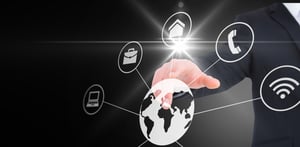Furthermore, in recent years we have seen a large percentage of the population connected via a mobile device – notice that I didn’t refer to the mobile device as a mobile phone?
I recall a statistic that was released by the U.N. back in 2013 on the eve of World Water Day. Out of the world’s estimated population of 7 billion people, 6 billion people have access to mobile phone. To put this in perspective, more people have access to a mobile phone worldwide than toilets.
After several failed attempts, we all remember PDAs (personal digital assistants) in the early 00s, the smart phone really took a foot hold by 2013. With their innovative touch screens that saw the demise of the old qwerty type keyboards found on Blackberrys.
In 2016 we now know that the smart phone or mobile device is the hub for connected platforms that all relate back to you. Google predicts that rather than referring to the web as the ‘Internet of Things’ it will and it has evolved into becoming the ‘Internet of Me’.
Optimising all of our interconnected platforms allows everybody to tailor this technology to simplify their life. We are relying on this type of technology more and more every day.
We can’t refer to these as just a mobile phone anymore as they do way more than make and receive phone calls remotely. Here are some of the additional functions that we use a mobile device for on a daily basis.
Mobile devices have become the remote control for our lives.
Remember too that if your mobile device can’t fulfil a need and perform a function in basic form there are thousands of apps available that are capable of providing solutions to your needs
The Mobile Device as a Hub
- Modern mobile devices have taken the standard phone call quite a few steps forward. Functions such as Facetime on iPhone have taken the average phone call and made them fully interactive even allowing both users to show their location via map.
- Text messaging was a massive evolution in communication. The ability to take a photograph and send it to the other side of the world in minutes is still staggering.
- Gaming and entertainment purposes. The forms of entertainment available at our finger tips is astonishing and let’s face it, usually free. From games, music, video, books, the mobile device has virtually replaced the format that most of these forms of entertainment originally were distributed with.
- Social media and internet browsing could almost be considered the primary function of smart phones.
- Even though my grandfather was a watchmaker and jeweller I use my mobile to check the time. Perhaps a progression by many but my mobile has replaced my need for a watch. I have no trouble determining the exact time in other countries either when doing business.
Furthermore, along the subject of time, the calendar on my mobile is a critical tool for scheduling tasks and my time management. Not only do my colleagues have access to my schedule but I even encourage clients to book meetings straight into my schedule.
- The HD camera and the ability of a mobile to take pictures. From there, we can store, edit, distribute and publish pictures all straight from the mobile device.
Smart Watch more than a watch for just reading the time
- Really popular with the health conscious. A smart watch can provide endless health and fitness related data: km walked, heart rate, sleep analytics, water intake, calories consumed and burned etc. Taking input from sensors on your body, you can pretty much monitor most metrics.
- Notifications: Tailor your presets to provide you with notifications on most subjects. Need to know the live football score? The current exchange rate of the Aussie dollar?
- Send and receive emails and text messages
- In conjunction with your mobile you can make and receive phone calls.
- Use ‘voice’ search to assist in your daily activities i.e. Siri
- GPS that provides clear directions to your destination.
- Pay bills
- Play music
- Check in on the weather forecast
- Oh, and you read the time.
C-Bus
Is a product offered by electrical supply company Clipsal, that provides home automation to control your domestic electrical appliances. The possibilities are endless for enhanced home safety, security and energy efficiency. This readily available technology has changed the live’s of the elderly and disabled
- Automated lighting that can scheduled
- Zoned heating and cooling systems
- Exhaust fans, ceiling fans, blinds, curtains, shutters and entertainment.
- The possibilities are endless – a close friend of mine is a green keeper for bowling clubs and now he can control his irrigation systems remotely depending on the constantly changing weather conditions.
Cars and the Automotive Industry
I visited a Tesla dealership in Martin Place, Sydney recently and was blown away by the features of the whole car to be honest. The connectivity of the car was as enhanced as it could be. Being an electric powered vehicle it made sense that it was connected to the internet
The dashboard was basically a computer that performed every web based function that you would find beneficial in a car.
The technology is now available where as you approach your car the door unlocks to allow entry.
You can start the car without a key and several personally individual presets within the vehicle will automatically adjust i.e. radio station, mirror position, seat position and adjustment etc.
The car can predict your destination from your calendar within your mobile phone.
The car can devise the best route and provide directions to your destination.
If you input to the car that you are hungry and want to eat on your way to your destination it can suggest some best options that align with your journey and even provide customer reviews of the restaurant to assist in your choice.
Add in the concept that some vehicles offer automated reverse parking functionality and driverless car technology is at it’s precipice.
The Future of Communication
I was talking to a marketing manager named Frank recently whose role is based in Boston but he was in Sydney to present at a function we were both at. I asked him to give me some insight into the progression of connectivity and I found his response thought provoking.
His first comment was that he didn’t understand the need for a phone number in today’s society…huh?
He went to explain that to stay in contact with his wife and young family whilst he travels the globe for his job, that if he phones home he has to navigate the arduous task of dialling with the correct exit codes.
These are also referred to as international access codes and international direct dialling (IDD). He went on to explain that there are far better options available for him to communicate with his wife such as Skype.
To use Skype, you utilise your existing online identity that you generally set up within your email and social media accounts. Typically, your identity is an avatar and username ‘icon’ that you just click to make the Skype call. There is no reason to dial a number as such.
I found this insight relatively simple but thought provoking.
It is easy to identify that this way of thinking is the future. Even payments can be made from your phone now that is virtually a digital wallet. The banks have teamed up to form a relationship with Apple Pay. The benefits outweigh the ease of payment in a purchase. Consider the potential for public transport fares, airlines, ticketing, store loyalty and rewards programs and that is just the start.
The Power of Google
Being in the online marketing industry we are a Google Partner and are in the front seat in regard to the goals of Google and their progression.
Historically Google is used as a search engine and they are quite forward thinking in their goal of predictive search. Google can analyse a user’s browsing history, location and demographic to predict what a user is searching for – perhaps best described as personalising the search function for an individual.
.png?width=113&name=sbf-logo-powered-by-hubshots-text%20white%20(1).png)
.png?width=320&height=132&name=sbf%20powered%20by%20hubshots%20(1).png)

